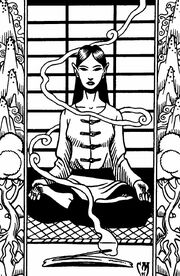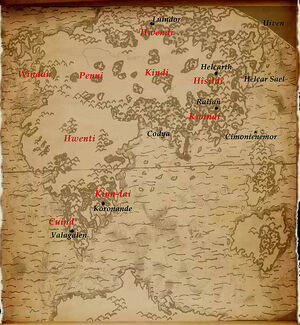| Line 115: | Line 115: | ||
***[[Pendi]] of [[Southernesse]] |
***[[Pendi]] of [[Southernesse]] |
||
****[[Lindê-Pendi]] |
****[[Lindê-Pendi]] |
||
| − | ****[[Mizdê- |
+ | ****[[Mizdê-Pendi]] |
****[[O'ô'-Pendi]] |
****[[O'ô'-Pendi]] |
||
***[[Pindi]] |
***[[Pindi]] |
||
Revision as of 23:45, 28 January 2020

An East-Elf
The Avari (Q.: "Refusers"; Tel. "Abari"; S.: "Evair" or ''Mornedhel'') or East-Elves were those Elves who did not go to the west in the Elder Days, but instead spread to the lands east and south due to the wars between Elves, Dwarves, Orcs and Men in the First Age.
Tribes of the Avari were known to have lived in Helcarth (or Helkanen), Khelkâ Sael, northern and southern Cuivienen (Helecerim or Hisildi), Blue Land (Blue Elves), Címóníemor, Rhûn, Rhovanion, Eriador, Aegan (Falassear), Ûster Kryl, Gondor, Haradwaith, Rálian, Mighty Green (Fuinar), Tâlirân, central Endor, Uiven and Beleriand (Eolrim).
History

Avari Tribes in Endor
After the great separation, the eastern Elves were led by Morwe and Nurwe until an elf called Tû appeared, who made himself a home near the great falls of Cuivienen and found many followers among the wandering Elves - known as the Hisildi.
After an Avar called Nuin, during his long wanderings to the south, had incidentally entered the hidded valley of Murmenalda within the Mountains of the Wind, he found the first sleeping children of Men. Soon after, the Avari began to take the young Hildor as their pupils and teach them what they knew of the world, but after some time both peoples drifted apart. This was partially the work of Morgoth, who had come to them in disguise and lured them away from their Elvish friends, and the voice of Eru that used to appear to them on and off. By the help of one of his lesser Maiar - a spirit called Fankil - Men built a great temple to worship Morgoth. Soon, Men started to quarrel among themselves, some listening to their Elven teachers while others listened to the lies of Fankil and contined to serve the temple. A war broke out with Avari, repenting Men and faithful Dwarves on one side and Orcs, unreasonable Men and corrupt Dwarves on the other side. After the great Battle of Palisor, Avari and Men sepatared, and the Avari themselves became scattered. Some of them - the Windan and Penni - following a Chieftain called Tareg to the Westlands. Others fled to the North, South or Farthest East. Though some of these tribes would remain loyal and fast friends to the men that fought with them in the Battle of Palisor--these tribes of Avari and Men would eventually make up the Rhun Forest and Dorwinion in the Third Age.
Appearance
The Avari were smaller than their Eldarin cousins, and those of Nelyarin descent were even smaller than their Tatyarin brethren, some barely reaching 6'. Most were dark-haired and dark-eyed, with a few copper-haired exceptions among the Tatyar and a few silver-haired and blond exceptions among the Nelyar. Their rejection of the sun and love for the stars and the nocturnal sky made them an unusually pale or sallow or silver-skinned people, although more lavender or olive complexions could be found among the Nelyar and dark, red or swarthy complexions among the Tatyar.
Culture
In comparison to the Eldar, the Avari were unlearned and primitive, never having been pupils of the Valar. They shunned the light of the sun and preferred to live a secluded life in the deep mountains, below the earth or in the deep and dark woodlands. They seldomly lived in larger settlements, and only those Nelyarin tribes that lived close to the Sea built boats and ships (and these were simple and primitive in comparison to the ships of the Eldar). Most Avari ignored the mortals; in ancient days, however, some Avar adopted newly-awakened Hildor children and thus taught them the rudiments of society, and their cultures were mingled before Men moved elsewhere and became sundered from them. Additionally, some Tatyar tribes had befriend the eastern Dwarves, especially those of the Stonefoot kindred, and had learned some of their smithcraft and stonemasonry. The Wild Elves may have been suspicious and peculiar, but they were never intentionally malevolent, and there was never any friendship between Dark Elves and Orcs or Trolls.
Speculations
- The very first appearance of an elvish people that could be considered Avari in Tolkien's works were the Hisildi from the Book of Lost Tales.These Elves lived in a land called Palisor in eastern Middle-earth between the Sea of Cuivienen and Hildorien to the south and ruled by a sorcerer-king called Tû or Túvo. Some of these Elves were led to the west by a leader called Tareg after the Battle of Palisor; these could be identified with the Penni, the Avari who had intermixed with the Nandor and had become the Silvan-Elves, and other Avari tribes mentioned to have lived in Beleriand, Eriador and Gondor. The other five tribes mentioned - the Windan, Hwenti, Cuind, Kinn-Lai and Kindi - could be identified with the Elves of Eriador, Haradwaith, Mighty Green, Mûmakan and the East-Plain. Two other Avari tribes - the Hwendi and Kwindi - are hypothetical and might linguistically be considered the ancestors of the latter five tribes. The Penni were believed to be Nelyarin-Avari while the other five tribes were believed to be Tatyarin-Avari. In general, the Nelyarin-Avari were intended to resemble the Teleri Elves - as sea or wood dwellers and either seafarers or hunters, and the Tatyarin-Avari to resemble more the Noldor - as craftsmen, cave-dwellers, warriors and friends of Dwarves.
Avari of Renown
Aiganar Alad'aron Irinn-las Ardanini Iridueni Arxdukanga Boah Agonar Calendal Khamthalun of Angmar Celedhen Chrys Menelrama Dardariann Darien Doronar Elerior of Cimonienemor Elewen Elor once Dark Enel Eol El'ugni Ivanna Jírdfos Laurrë Skywanderer Lianna Lindal Lindetaro Lôsdalas Lydek Terisonen Lyerin Lyrin Midhir Mirag Morloth Mormiresûl Morwe Morwened Mourmaelgax Namu the Rain-man Nandar Nuin Nurwe Nurwen Orthir Rána of Tumlinde Andai Inda'eir Randae Terisonen Ingi'inda Grey-cloaked Sûlcû Sûlherok Tareg Taurclax Tiuri-onnu Terilaen Tû Tûranar Ulgarin Valandor Bil-nirr Bil-surr Bilig-lann
Avari Family Tree
- Tatyarin Avari or Loari
- Hwendi (Blue Elves)
- Hwenti
- Elves of the Suncrown
- Windan
- Eolrim
- Hvettir
- Mountain-Elves
- Hwenti
- Kwindi (Helecerim)
- Elves of Rálian
- Cuind (Fuinar)
- Elves of Mighty Green
- Kindi
- Elves of Ûster Kryl
- Kuorind of Lómeänor
- Kinn-Lai
- Namarian
- Hwendi (Blue Elves)
- Nelyarin Avari or Erlini
- Hwanin or Pendi
- Pen-lie
- Pendi of Southernesse
- Pindi
- Pêdi
- Elves of Taarun and Imaldawath
- People of Lôs in Ibav
- Elves of Címóníemor
- Elves of Taarun and Imaldawath
- Pái
- Muri of the Inner Seas
- Penni
- Hwanin or Pendi
